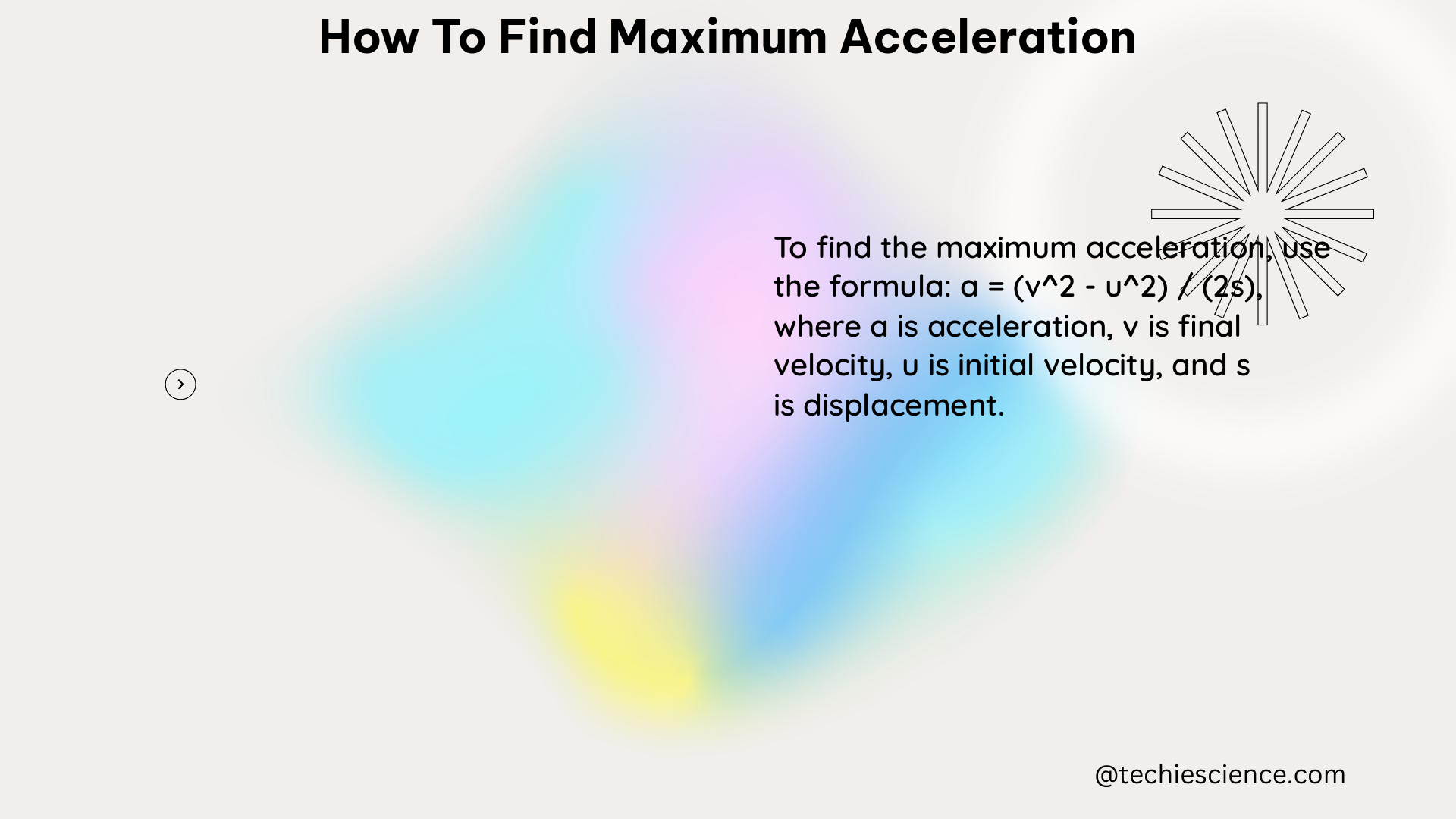Determining the maximum acceleration of an object is a crucial step in understanding its motion and dynamics. This comprehensive guide will walk you through the step-by-step process of finding the maximum acceleration, complete with technical details, formulas, examples, and numerical problems to help you master this concept.
Understanding Velocity and Acceleration Functions
The first step in finding the maximum acceleration is to determine the velocity function, v(t), which is the first derivative of the position function, x(t). Once you have the velocity function, you can then find the acceleration function, a(t), which is the first derivative of the velocity function, v(t).
The general formula for finding the acceleration function is:
a(t) = dv(t)/dt
where dv(t)/dt represents the first derivative of the velocity function with respect to time.
Example 1: Velocity and Acceleration Functions
Let’s consider the following example:
Suppose the position function of an object is given as x(t) = -t^3 + 6t^2 + 2t. To find the maximum acceleration, we need to follow these steps:
-
Determine the velocity function,
v(t):
v(t) = dx(t)/dt = -3t^2 + 12t + 2 -
Determine the acceleration function,
a(t):
a(t) = dv(t)/dt = -6t + 12
Now, we have the necessary functions to proceed with finding the maximum acceleration.
Finding the Maximum Acceleration

To find the maximum acceleration, we need to analyze the acceleration function, a(t), and determine the time at which the maximum acceleration occurs. This can be done by following these steps:
- Find the time at which the slope of the tangent line to the acceleration function is equal to zero.
- Verify that the point found in step 1 is a maximum using the second derivative test.
Step 1: Finding the Time of Maximum Acceleration
To find the time at which the maximum acceleration occurs, we need to find the time when the first derivative of the acceleration function, a'(t), is equal to zero.
Continuing the example from above:
a'(t) = -6t + 12 = 0
-6t = -12
t = 2
So, the maximum acceleration occurs at t = 2.
Step 2: Verifying the Maximum Acceleration
To verify that the point found in step 1 is a maximum, we can use the second derivative test. If the second derivative of the acceleration function, a''(t), is negative at the point where a'(t) = 0, then the point is a maximum.
Continuing the example:
a''(t) = -6
Since a''(t) = -6 is always negative, we can conclude that the point at t = 2 is a maximum.
Example 2: Numerical Problem
Suppose an object’s position function is given as x(t) = 4t^2 - 3t + 2. Find the maximum acceleration of the object.
Solution:
1. Determine the velocity function, v(t):
v(t) = dx(t)/dt = 8t - 3
-
Determine the acceleration function,
a(t):
a(t) = dv(t)/dt = 8 -
Find the time at which the maximum acceleration occurs:
a'(t) = 0
8 = 0
t = 0 -
Verify the maximum acceleration:
a''(t) = 0
Therefore, the maximum acceleration of the object is 8 units/s^2, and it occurs at t = 0.
Additional Considerations
- In some cases, the acceleration function may not have a simple analytical expression, and you may need to use numerical methods or graphical analysis to find the maximum acceleration.
- For more complex motion, such as simple harmonic motion or oscillating systems, the process of finding the maximum acceleration may involve additional steps and considerations.
- It’s important to understand the physical meaning and implications of the maximum acceleration in the context of the problem you’re solving.
Conclusion
Finding the maximum acceleration of an object is a fundamental skill in physics and engineering. By following the step-by-step process outlined in this guide, you’ll be able to determine the maximum acceleration for a wide range of motion problems. Remember to practice with various examples and numerical problems to solidify your understanding of this concept.
References
- How to Calculate the Maximum Acceleration of an Oscillating Particle: https://study.com/skill/learn/how-to-calculate-the-maximum-acceleration-of-an-oscillating-particle-explanation.html
- Calculating the Maximum Acceleration of an Object in Simple Harmonic Motion: https://study.com/skill/learn/calculating-the-maximum-acceleration-of-an-object-in-simple-harmonic-motion-explanation.html
- Quantitative Motion Analysis – Body Physics: Motion to Metabolism: https://openoregon.pressbooks.pub/bodyphysics/chapter/quantitative-motion-analysis/

The lambdageeks.com Core SME Team is a group of experienced subject matter experts from diverse scientific and technical fields including Physics, Chemistry, Technology,Electronics & Electrical Engineering, Automotive, Mechanical Engineering. Our team collaborates to create high-quality, well-researched articles on a wide range of science and technology topics for the lambdageeks.com website.
All Our Senior SME are having more than 7 Years of experience in the respective fields . They are either Working Industry Professionals or assocaited With different Universities. Refer Our Authors Page to get to know About our Core SMEs.